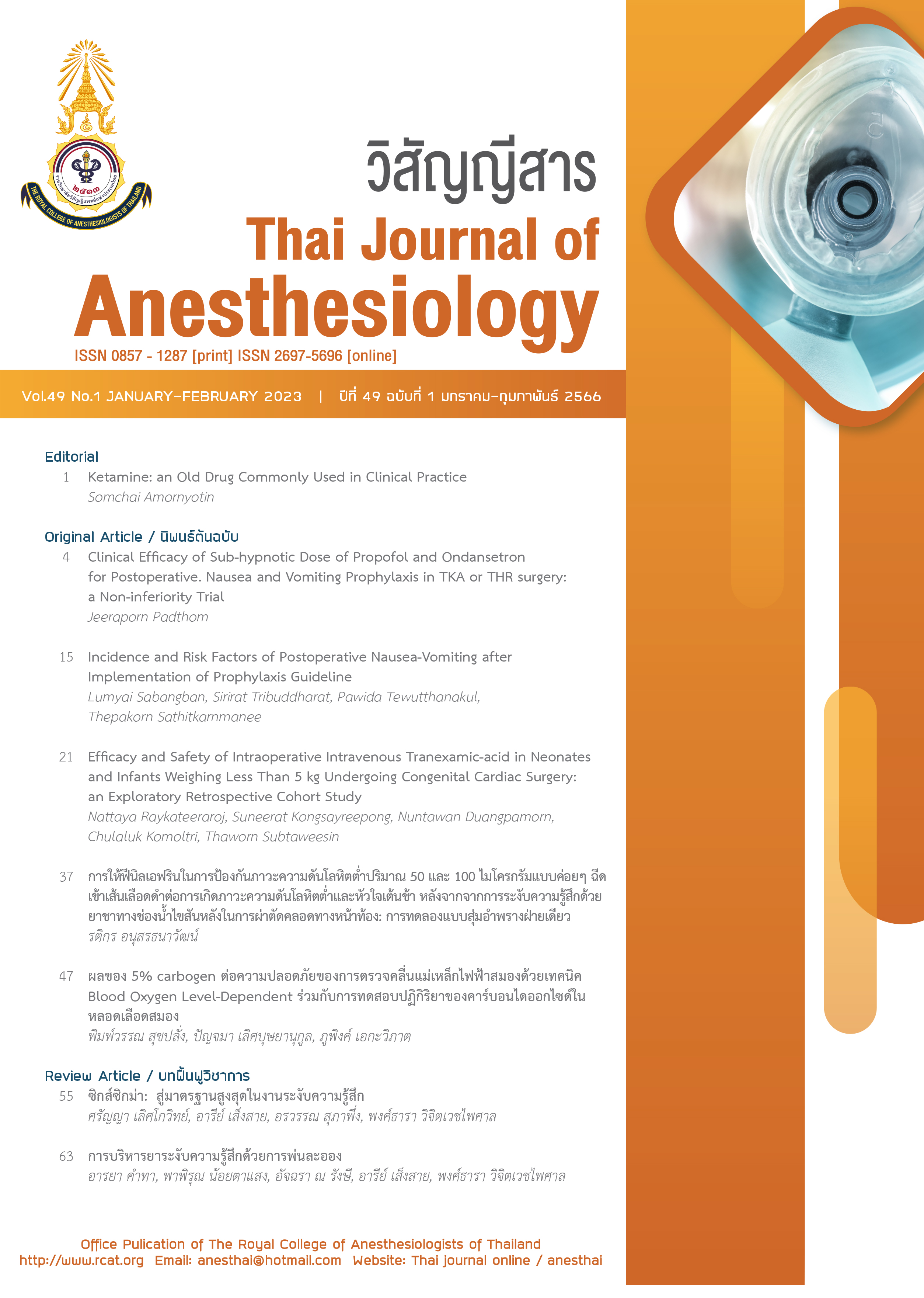การบริหารยาระงับความรู้สึกด้วยการพ่นละออง
Main Article Content
บทคัดย่อ
มนุษย์หายใจเอาอากาศเข้าสู่ปอด เพื่อนำออกซิเจนไปใช้ในกระบวนการสันดาปอาหาร ได้เป็นพลังงานสำหรับร่างกายนำไปใช้ในกิจการต่างๆ อากาศที่หายใจเข้าไป ไม่เพียงประกอบด้วยออกซิเจน ไนโตรเจน คาร์บอนไดออกไซด์ หรือก๊าซเฉื่อยเท่านั้น ยังมีไอน้ำ ฝุ่นละออง อนุภาค เชื้อโรคและจุลินทรีย์อีกหลายชนิด อนุภาคที่มีขนาด 0.1-200 ไมครอน (micron or micrometer; 1 µm = 1/1,000 millimeter) จะถูกสูดดมผ่านเข้าสู่ทางเดินหายใจได้อย่างสะดวก เมื่อเข้าไปแล้วจะมีการกระจายตัวใน 4 ลักษณะด้วยกัน มากหรือน้อยขึ้นอยู่กับขนาด รูปร่าง และความหนาแน่นของอนุภาคนั้นๆ ถ้ามีขนาดเส้นผ่าศูนย์กลางน้อยกว่า 0.5 ไมครอน อนุภาคจะกระจายตัวอย่างไร้จุดหมาย ไม่แตกต่างอะไรกับการเคลื่อนไหวของก๊าซ (Brownian motion) ส่วนใหญ่จะลอยฟุ้งเข้าออกตามการหายใจ ถ้ามีขนาด 0.5-1 ไมครอน น้ำหนักของมวลที่ต้องต้านกับแรงเสียดทานในทางเดินหายใจ จะทำให้ตกตะกอนไปเกาะอยู่ตามแขนงหลอดลมขนาดเล็กหรือภายในถุงลมปอด ส่วนอนุภาคขนาดมากกว่า 1 ไมครอน หรือมีลักษณะเป็นเส้นใย เช่น ฝุ่นใยแก้ว (asbestos) จะเข้ายึดเกาะกับผนังทางเดินหายใจ และถ้ามีขนาดใหญ่กว่า 10 ไมครอน จะตกค้างบริเวณทางแยกของทางเดินหายใจ เช่น ภายในโพรงจมูกและหลอดคอ ทั้งนี้ขึ้นอยู่กับความเร็วของอากาศที่ไหลผ่านและมวลของอนุภาคเป็นสำคัญ การรักษาและบรรเทาโรคต่างๆในระบบทางเดินหายใจ สามารถอาศัยการบริหารยาได้หลายรูปแบบ คือ ชนิดรับประทาน ชนิดฉีด หรือชนิดสูดดมเข้าสู่ทางเดินหายใจ โดยเฉพาะการบริหารยาโดยการสูดดม เป็นอีกหนึ่งวิธีที่มีประสิทธิภาพในการนำตัวยาเข้าสู่ร่างกาย ผ่านทางช่องจมูก ช่องปาก คอหอย กล่องเสียง หลอดลม และหลอดลมแขนงย่อย ก่อนที่ยาจะถูกดูดซึมบริเวณเนื้อเยื่อถุงลมปอดกว่าข้างละ 300 ล้านหน่วย คิดเป็นพื้นที่ผิวมากถึง 75 ตารางเมตร5 ซึ่งเป็นการออกฤทธิ์โดยตรงที่ตำแหน่งเป้าหมาย การศึกษาพบว่า ในการบริหารยาแต่ละครั้ง ละอองยาจะออกฤทธิ์เพียงร้อยละ 10-206 เนื่องจากละอองส่วนมากที่มีขนาดใหญ่ จะเกาะตามผนังหรือทางแยกตลอดทางเดินหายใจ จึงส่งผลข้างเคียงค่อนข้างน้อยกว่าการบริหารยาด้วยวิธีอื่น และสามารถบริหารยาซ้ำได้อย่างปลอดภัย
Article Details

อนุญาตภายใต้เงื่อนไข Creative Commons Attribution-NonCommercial-NoDerivatives 4.0 International License.
เอกสารอ้างอิง
Heyder J. Deposition of inhaled particles in the human respiratory tract and consequences for regional targeting in respiratory drug delivery. Proc Am Thorac Soc. 2004;1:315-20.
Sung JC, Pulliam BL, Edwards DA. Nanoparticles for drug delivery to the lungs. Trends Biotechnol. 2007;25:563-70.
Gardenhire DS, Burnett D, Strickland S, Myers TR. A guide to aerosol delivery devices for respiratory therapists. 4th ed. American Association for Respiratory Care; 2017, p1-61. [Internet] [cited 2021 Feb 15]. Available from: http://c.aarc.org/go/adu. aerosol_guide_rt.pdf (aarc.org)
Hess DR. Nebulizers: principles and performance. Respir Care. 2000;45:609-22.
Guyton AC. Respiration. In: Guyton AC, Hall JE, editors. Textbook of Medical Physiology. 11th ed. Pennsylvania: Elevier Inc; 2006, p465-522. [Internet] [cited 2021 Apr 25]. Available from: https://www.moscmm.org/pdf/Guyton%20physiology.pdf
Dolovich MB, Dhand R. Aerosol drug delivery: developments in device design and clinical use. Lancet. 2011;377:1032-45.
Barnes PJ. Distribution of receptor targets in the lung. Proc Am Thorac Soc. 2004;1:345-51.
Zebraski SE, Kochenash SM, Raffa RB. Lung opioid receptors: pharmacology and possible target for nebulized morphine in dyspnea. Life Sci. 2000;66:2221-31.
Rubin BK, Fink JB. Optimizing aerosol delivery by pressurized metered-dose inhalers. Respir Care. 2005;50:1191-200.
Islam N, Gladki E. Dry powder inhalers (DPIs)-a review of device reliability and innovation. Int J Pharm. 2008;360:1-11.
Webmed. Nebulizers: definition, types, uses, and cleaning [Internet]. 2021 [updated 2017 Aug 03; cited 2021 Feb 07]. Available from: https://www.webmd.com/asthma/guide/home-nebulizer-therapy
Dennis JH, Stenton SC, Beach JR, Avery AJ, Walters EH, Hendrick DJ. Jet and ultrasonic nebuliser output: use of a new method for direct measurement of aerosol output. Thorax. 1990;45:728-32.
Ghazanfari T, Elhissi AM, Ding Z, Taylor KM. The influence of fluid physicochemical properties on vibrating-mesh nebulization. Int J Pharm. 2007;339:103-11.
Labiris NR, Dolovich MB. Pulmonary drug delivery. Part II: the role of inhalant delivery devices and drug formulations in therapeutic effectiveness of aerosolized medications. Br J Clin Pharmacol. 2003;56:600-12.
Ari A. Jet, Ultrasonic, and Mesh nebulizers: an evaluation of nebulizers for better clinical outcomes. Eurasian J Pulmonol. 2014;16:1-7.
Bertrand P, Araníbar H, Castro E, Sánchez I. Efficacy of nebulized epinephrine versus salbutamol in hospitalized infants with bronchiolitis. Pediatr Pulmonol. 2001;31:284-8.
Seale JP. Anticholinergic bronchodilators. Aust Prescr. 2003;26:33-5.
Kaabachi O, Ouezini R, Hajjej Z, Rais K, Koubaa W. Comparative study between mask nebulisation and oral administration of midazolam for premedication in children. Eur J Anaesthesiol. 2008;25:158.
Mounika M, Aswathy R, Shriyan A, Roshan AO. Comparison of sedation scores after nebulized and intravenous Midazolam in children. Int J Contemp Pediatr. 2018;5:1083-6.
Abdel-Ghaffar HS, Kamal SM, El Sherif FA, Mohamed SA. Comparison of nebulised dexmedetomidine, ketamine, or midazolam for premedication in preschool children undergoing bone marrow biopsy. Br J Anaesth. 2018;121:445-52.
Zanaty OM, El Metainy SA. A comparative evaluation of nebulized dexmedetomidine, nebulized ketamine, and their combination as premedication for outpatient pediatric dental surgery. Anesth Analg. 2015;121:167-71.
Misra S, Behera BK, Mitra JK, Sahoo AK, Jena SS, Srinivasan A. Effect of preoperative dexmedetomidine nebulization on the hemodynamic response to laryngoscopy and intubation: a randomized control trial. Korean J Anesthesiol. 2021;74:150-7.
Leaker BR, Barnes PJ, Jones CR, Tutuncu A, Singh D. Efficacy and safety of nebulized glycopyrrolate for administration using a high efficiency nebulizer in patients with chronic obstructive pulmonary disease. Br J Clin Pharmacol. 2015;79:492-500.
Carter NJ. Inhaled glycopyrronium bromide. A review of its use in patients with moderate to severe chronic obstructive pulmonary disease. Drugs. 2013;73:741-53.
Orji MO, Osinaike BB, Amanor-Boadu SD, Ugheoke A. Nebulized magnesium versus ketamine for prevention of post-operative sore throat in patients for general anesthesia. Ann Ib Postgrad Med. 2020;18:3-8.
Slaton RM, Thomas RH, Mbathi JW. Evidence for therapeutic uses of nebulized lidocaine in the treatment of intractable cough and asthma. Ann Pharmacother. 2013;47:578-85.
Fattah Kamel AAF, Ibrahem Amin OAI. The effect of preoperative nebulized: magnesium sulfate versus lidocaine on the prevention of post-intubation sore throat. Anaesthesia. 2020;36:1-6.
Knightly R, Milan SJ, Hughes R, et al. Inhaled magnesium sulfate in the treatment of acute asthma. Cochrane Database Syst Rev. 2017;11:1-98.
Furyk JS, Grabowski WJ, Black LH. Nebulized fentanyl versus intravenous morphine in children with suspected limb fractures in the emergency department: a randomized controlled trial. Emerg Med Australas. 2009;21:203-9.
Thompson JP, Thompson DF. Nebulized fentanyl in acute pain: a systematic review. Ann Pharmacother. 2016;50:882-91.


